Vol 4 No. 10 TROPIC LIGHTNING NEWS March 10, 1969
Index
| Unit Page | Unit Page | Unit Page | Unit Page |
| 1/27 1 | 2/14 Photo 7 | 25th Med 6 | 4/9 7 |
| 1/27 4 | 2/14 7 | 269 AHC 7 | 4/9 8 |
| 1/27 Photo 4 | 2/22 1 | 3rd Bde 3 | 4/23 6 |
| 1/27 7 | 2/22 7 | 3/22 Photo 1 | 5/2 Arty 7 |
| 1/27 8 | 2/27 1 | 3/4 Cav 8 | 65th Engr 6 |
| 187 AHC Photo 1 | 2/27 Photo 7 | 4/9 3 | 65th Engr Photo 7 |
| 2/12 2 | 2/27 Photo 8 | 4/9 6 | 66 Inf Trackers 6 |
| 2/12 8 | 25th Med 3 | 4/9 7 |
NVA
Try Daring Dau Tieng Siege,
All-Night Battle Rids Base Of Foe
DAU
TIENG
- Lifting an all-night siege of Dau Tieng base comp, infantrymen, cooks, clerks
and other support soldiers of the 3d Brigade killed 73 enemy who had overrun
portions of the installation. There
were 14 detainees.
By the time a red alert was
called, shortly after midnight, portions of the camp's perimeter had already
been overrun. For more than eight
hours North Vietnamese Army soldiers held a rubber forest near the south end of
the camp and a part of the camp near the east end of the Dau Tieng air strip.
At the height of the
fighting, when the enemy flanked brigade headquarters from two sides, Major
General Ellis W. Williamson, 25th Infantry Division commanding general, flew his
helicopter into Dau Tieng personally and led the counterattacks that drove off
the enemy.
Colonel Louis J. Sehelter,
Jr., brigade commander, of Columbus, Ga., said, "The troops performed
magnificently. In every respect they did the job that had to be done."
The North Vietnamese troops,
attacking in a force of two battalions, hit the base camp from four sides,
storming the perimeter at two points and also entering by way of a tunnel.
They surrounded portions of the bunker line and trapped a number of
Tropic Lightning soldiers behind the lines.
During the attack hundreds of rounds of rockets, mortars, and RPG's
struck the base camp.
Some of the heaviest
fighting centered around an area of French buildings and swimming pools just
south of brigade headquarters. The
NVA mounted a machinegun on the porch of the base library while a group of five
infantrymen huddled inside with rifles trained on the doors.
All night long the NVA kept
a force of combat engineers and infantrymen pinned down in ditches alongside a
road in front of the old house belonging to the Michelin family of French rubber
planters.
At dawn, a group of enemy
snipers had holed up inside the Michelin house and were laying down fire into
areas controlled by the military police and brigade headquarters.
Special Forces troops and a
40mm duster leveled portions of the second floor of the house killing some of
the snipers.
Meanwhile armored personnel
carriers of the 2d Battalion (Mechanized), 22d Infantry, and Wolfhounds of the
1st Battalion, 27th Infantry, along with an assortment of support personnel,
blasted the main enemy force away from the area near the swimming pools.
Four dead NVA lay in a road beside the officers' pool when the fighting
stopped.
The enemy retreated past the
post exchange and into the woods near the base camp communications center of the
587th Signal Company's White Platoon. Heavy
fighting drove this force of NVA toward the perimeter.
Meanwhile other Triple Deuce
armored personnel carriers drove the enemy off the east end of the air strip,
but not before several spotter planes and a helicopter had been damaged with
satchel charges.
With the coming of daylight
and the driving out of enemy main forces, there remained the job of cleaning out
snipers from many of the base camp's trees.
This job took almost until noon. Shortly
after one p.m., a group of eight soldiers was found hiding inside a culvert near
the (Continued on Back Page)
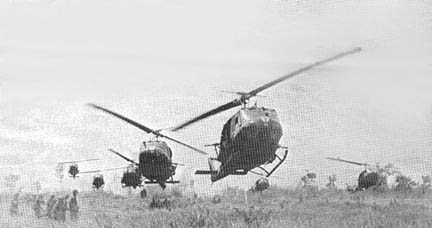 |
| IT'S AS EASY AS ONE, TWO, THREE - Members of the 3d Battalion, 22d Infantry wait to be picked up by Crusader slicks of the 187th Assault Helicopter Company northwest of Tay Ninh. (PHOTO BY SP4 DAVE DEMAURO) |
FSB
Diamond Thwarts Fierce Attack
By
1LT J. N. Black
CU CHI
- While North Vietnamese forces took more than 100 U.S. bases under fire the 2d
Brigade Fire Support Base Diamond blatantly challenged the enemy only three
clicks from the Cambodian border, tempting the Reds to strike.
At approximately two a.m.
the 2d Battalion, 27th Infantry soldiers received initial small arms and mortar
fire from positions along the Cambodian border.
With rapid reactions, the U.S. troops called in supporting artillery and
gunships to blast the enemy.
However the hard-hitting NVA
attack came swiftly and vigorously from the south forcing the Americans into
last ditch efforts. The ruthless
advances of the estimated two regiments made normal reactionary procedures
impossible and only close defensive artillery fires could rout the persistent
NVA.
During the 10-hour battle
the small U.S. base put out maximum fire power. Air strikes and artillery forced
the NVA into the killing zone.
By the afternoon of Feb. 23,
the Americans had tallied some 109 enemy bodies and later sweeps uncovered
another eighteen. Weapons captured
included 12 AK-47's, seven RPG launchers and 53 rounds, two pistols, three
60mm mortars complete and 15 rounds, four 82mm mortar rounds, a quarter pound of
enemy documents and assorted small arms and munitions.
During the next 24 hours the
2d Brigade Wolfhounds stood prepared but unchallenged by the inscrutable enemy.
Yet on the early morning of the 25th the 9th Division NVA made a fast but
futile second assault on Diamond.
Again, rockets and mortars
rained in on U.S. positions announcing the attack, but staunchly prepared Tropic
Lightning soldiers defended the base, killing 78 enemy with a possible 50 more,
taking two wounded prisoners and capturing an arsenal of weapons.
The Tropic Lightning victory
was credited to three main factors. The
first factor was the hard fighting, platoon-sized ambush patrols which were
located in the path of the oncoming attacks.
A second factor was the skilled infantrymen and artillerymen who defended
the perimeter. The last factor was
the truly devastating fire laid down by Tropic Lightning artillery, gunships,
and tactical air strikes.
The ambush patrols kept the
enemy off balance, as he initiated the early morning attack. As the fighting erupted an ambush patrol south of the Fire
Brigade base found itself surrounded by a large enemy force.
Artillery was called in surrounding Wolfhounds with a wall of flying
shrapnel. The persistent enemy
continued his march to the small base despite the heavy artillery.
Platoon Sergeant Gonzales A.
Marquez, Columbus, Ga., said, "I shot my M-16 into the chest of an enemy
soldier and pulled the trigger."
The ambush patrol, now
fighting for its life, was forced to fight its way through masses of well-armed
enemy.
An ambush patrol to the
north found itself on the flank of a massive NVA force.
They directed artillery into the enemy and knocked out two mortar
positions, disorganizing the planned attack.
The North Vietnamese force
attacked Diamond's wire under (Continued on Back Page)
Page 2 TROPIC LIGHTNING NEWS March 10, 1969
Decorated
| MAJ Frederick H.
Bornemen, HHC, 2d Bn, 27th Inf CPT Harry L. Ikner, Co C, 2d Bn, 27th Inf CPT John H. Goodrich, HHC, 2d Bn, 14th Inf CPT Luis Ortiz, A Btry, 3d Bn, 13th Arty CPT Jack Zeagler, HHB, 1st Bn, 8th Arty 1LT Gregory W. Gross, A Co, 3d Bn, 22d Inf 1LT John M. Johnson, A Btry, 3d Bn, 13th Arty 1LT John D. Peterson, A Trp, 3d Sqdn, 4th Cav 1LT James A. Valentine, A Btry, 3d Bn, 13th Arty 1LT Paul W. Green Jr., A Btry, 7th Bn, 11th Arty 1LT Richard H. Booth, HHC, 3d Bn, 22d Inf 1LT John A. Weldon, Co A, 2d Bn, 22d Inf 1LT Jerry D. Pruitt, HHC, 2d Bn, 12th Inf SFC Andrew E. Hughes, A Btry, 3d Bn, 13th Arty SFC Kenneth H. Mueller, Co B, 4th Bn, 23d Inf SFC Kenneth H. Strocsher, B Co, 1st Bn, 5th Inf SFC William Yingling, A Trp, 3d Sqdn, 4th Cav SFC Therman L. Lowery, D Btry, 3d Bn, 13th Arty SFC Jimmy L. Hill, D Btry, 3d Bn, 13th Arty SSG Lawson Walker, C Co, 1st Bn, 5th Inf SSG James R. Harvey, A Btry, 3d Bn, 13th Arty SSG Layton K. Pfost, A Trp, 3d Sqdn, 4th Cav SSG Edward Rutledge, Co C, 3d Bn, 22d Inf SSG Harold Taylor, A Btry, 3d Bn, 13th Arty SGT Robert A. Adams, Co B, 4th Bn, 23d Inf SGT Danny F. Justice, Co D, 4th Bn, 9th Inf SGT Robert Clark, Co D, 3d Bn, 22d Inf SGT Robert M. Cosgrove, B Co, 2d Bn, 12th Inf SGT John E. Reeves, B Co, 2d Bn, 12th Inf SGT Ernest McComus, Co C, 3d Bn, 22d Inf SGT George Hatfield, Co D, 3d Bn, 22d Inf SGT William McCullough, HHC, 3d Bn, 22d Inf SGT Darrell Wallace, B Trp, 3d Sqdn, 4th Cav SGT Donald Rogers, Co D, 3d Bn, 22d Inf SGT Roland Zengel, Co D, 3d Bn, 22d Inf SGT William C. Smith, Co B, 1st Bn, 5th Inf |
SP5 Donald B.
Lemmen, B Co, 65th Engr Bn SP4 Michael Hanna, B Co, 2d Bn, 12th Inf SP4 Gary B. Robertson, C Co, 1st Bn, 5th Inf SP4 Ronald L. Osowski, B Co, 2d Bn, 12th Inf SP4 Michael A. Minko, C Co, 4th Bn, 9th Inf SP4 David Bolling, C Btry, 7th Bn, 11th Arty SP4 Jon J. Teschner, D Co, 1st Bn, 5th Inf SP4 Thomas E. Ladner, D Btry, 3d Bn, 13th Arty SP4 Paul Rogers, HHC, 3d Bn, 22d Inf SP4 Denis Marc-Aurele, A Co, 1st Bn, 5th Inf SP4 Fredric Moffit, D Co, 3d Bn, 22d Inf SP4 John Collins, A Co, 2d Bn, 12th Inf SP4 Douglas Blood, B Co, 1st Bn, 5th Inf SP4 Virgil Malone, A Co, 3d Bn, 22d Inf SP4 Ronald Boyd, A Trp, 3d Sqdn, 4th Cav SP4 Minter Garvin, A Trp, 3d Sqdn, 4th Cav SP4 Steven Bailey, A Co, 1st Bn, 5th Inf SP4 Larry Wilson, A Trp, 3d Sqdn, 4th Cav SP4 Jimmy Miller, HHC, 3d Bn, 22d Inf SP4 James Jones, Co C, 3d Bn, 22d Inf SP4 John Pock, HHC, 4th Bn, 9th Inf SP4 Fred Graham, Co C, 3d Bn, 22d Inf SP4 Henry R. Erber, A Trp, 3d Sqdn, 4th Cav SP4 Edward J. Finerty, HHC, 2d Bn, 27th Inf SP4 David Chedester, Co D, 3d Bn, 22d Inf SP4 Robert T. Dunn, Co D, 3d Bn, 22d Inf SP4 William P. Quoss, Co B, 4th Bn, 23d Inf PFC Johnny Foust, D Co, 3d Bn, 22d Inf PFC Phillip L. Peieffer, HHC, 2d Bn, 12th Inf PFC Arcadio J, Torres, A Co, 2d Bn, 27th Inf PFC Edwin A. Miller, C Co, 4th Bn, 9th Inf PFC Robert M. Hoover, HHC, 2d Bn, 12th Inf PFC Everet Chreene, D Co, 1st Bn, 5th Inf PFC Larry Steele, HHC, 1st Bn, 5th Inf PFC Johnnie Bruno, HHC, 3d Bn, 22d Inf PFC John Murphy, A Co, 1st Bn, 5th Inf |
Uncle
Gives Opportunities And Bennies During Your Viet Tour
Everyone knows there is a
job to be done in Vietnam. Your
career counselor would also like to make you aware of the benefits and
opportunities available to you during your tour here.
For example, have you ever given any thought about how much additional
money you make and save while in Vietnam?
First off, all pay and
allowances for enlisted men are tax-free. All
of the withholding taxes taken from your pay in the States are a part of your
month's pay in Vietnam.
That's just a start.
Add the extras. Depending upon your rank, you receive an additional $8 to
$22.50 a month foreign duty pay. That's
tax-free. Hostile-fire pay means
another $65 a month, again tax-free.
Well, there is free postage
and up to seven days of R&R for every 12 months of service. For this R&R, the Army flies you free of charge to such
locations as Hong Kong, Bangkok, Tokyo, Singapore, Australia and Hawaii.
You may also go on a three-day pass within Vietnam.
When your one-year tour of
duty is over, and if you decide to extend in the country for an additional six
months, you will be given 30 days of non-chargeable leave, including free
round-trip transportation to almost any point in the free world that you select.
For the man who does not
want to extend his tour in Vietnam, there are other opportunities.
Toward the end of a Vietnam tour, any enlisted person, regardless of pay
grade, may re-enlist for the CONUS Station-of-Choice option.
This assures a one-year stabilized tour at the stateside station you
choose. It is normally open only to enlisted men in grades E-1 to E-6. In Vietnam it is open to everyone regardless of grade.
The Oversea Area-of-Choice
option is another re-enlistment opportunity open to enlisted men in Vietnam.
It is available to men in grade E-5 or below with less than seven years
active federal service. It is also offered to those in grade E-6 who have less than
four years service for pay purposes. It
is ideal for the family man.
A third option for which the
enlisted man is eligible is the drill sergeant re-enlistment program.
It offers a stabilized tour of 18 months at a stateside training center
of the man's choice. Qualified NCOs and Specialists in grades E4 through E-7 can
re-enlist for this duty while in Vietnam or any other unaccompanied short-tour
area.
A big advantage of the drill
sergeant program is that a man can be promoted from E-5 to E-6 without regard to
time in grade or service. Eligibility
lists for this fast promotion opportunity are made up from those drill sergeants
with four months of outstanding performance.
So, as you see, a tour in
Vietnam offers both financial and career advantages.
Your career counselor has all of the details about this and other career
opportunities. He welcomes your
visits.
In Cu Chi, you can find your
career counselor in building T3586. Or
just call Cu Chi 5234. If you have
questions, don't hesitate. Find
out today.
OGS
Recruit Required To Take Three
On March 1, 1969, there were
changes in the rules governing the active duty obligation for enlisted men
selected for OCS. College option
applicants and inductees who volunteer for the program must enlist for a
three-year period upon being chosen for OCS.
Soldiers who enlisted for
less than three years must extend a minimum of 12 months. However, college option enlistees who entered the Army prior
to March 1,1969, will continue with their previously stated active-duty
obligations.
Members of a Reserve
component on active duty must agree to complete a minimum of three years total active federal military service.
Individuals on a three year
enlistment who have less than six months remaining on their current term of
service must extend a sufficient period of time to enable them to complete OCS
training. The same rule applies for
members of the Regular Army and Reserve components who have over three years
active federal military service but insufficient time left to finish OCS.
Total time spent in service
for those commissioned from OCS will not be affected since graduates will
continue to serve two years active duty as commissioned officers.
Those desiring more
information are encouraged to see their career counselor.
Solve
Dollar Woes: Army
Savings Plan
For many years past the
United States of America has had, and still has an unfavorable international
balance of payments. This has
caused great concern not only to our government, but also to international
financial circles and foreign governments.
Our international
commitments, including the stationing of military units in oversea areas are
contributing to this unfavorable situation.
We in the military, and our dependents spend U.S. dollars in foreign
local economies, thus putting a strain on the gold reserves of our government.
One important method of
reducing gold flow is to curtail individual spending on the local economy by
withdrawing as many dollars from circulation as possible.
Here are some of the ways you can participate and help yourself out in
the long run too:
Buy U.S. Savings Bonds. The
interest is higher than ever.
Use the military banking
facilities in Vietnam. They pay 5 per cent interest on checking accounts if the
balance does not fall under $100.
Sign Up for the Uniform
Services Savings Deposit Program. You
do this by depositing cash with your finance officer, or authorizing a certain
amount to be withheld from your pay each month.
Check with your finance
officer soon. You can help yourself
and your government.
TROPIC
LIGHTNING
Combat Honor Roll
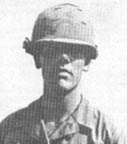 Added to the Tropic Lightning honor roll this week is Specialist 4 Ronald
C. Carey of Company B, 2d Battalion, 12th Infantry.
Added to the Tropic Lightning honor roll this week is Specialist 4 Ronald
C. Carey of Company B, 2d Battalion, 12th Infantry.
On the night of January 7,
Company B came under heavy attack at its night laager.
Carey could not effectively engage the enemy from his location, and ran
through a bullet-swept area to a hedgerow.
Reaching the more advantageous position, Carey began to place deadly fire
on the insurgents until his machine gun was rendered inoperable.
He then secured an M-16 rifle and returned to the perimeter of the night
laager where he continued to place effective fire on the aggressors.
After his ammunition was
expended, he once again exposed himself to heavy fire. He then resumed his
accurate fire on the enemy, this time with an M-79 grenade launcher.
Specialist Carey's
personal bravery, aggressiveness and devotion were of immeasurable aid to his
unit as it turned back the hostile attack.
The TROPIC LIGHTNING NEWS is an authorized publication of the 25th Infantry Division. It is published weekly for all division units in the Republic of Vietnam by the Information Office, 25th Infantry Division, APO San Francisco 96225. Army News Features, Army Photo Features, Armed Forces Press Service and Armed Forces News Bureau material are used. Views and opinions expressed are not necessarily those of the Department of the Army. Printed in Tokyo, Japan, by Pacific Stars and Stripes.
MG Ellis W. Williamson . . . . Commanding General
MAJ John C. Fairbank . . . . . Information Officer
2LT Don A. Eriksson . . . . . . Officer-in-Charge
SP4 Stephen Lochen . . . . . . Editor
SP4 Charles Withrow . . . . . . Assistant Editor
SP4 Jim Brayer . . . . . . . . . . . . Production Supervisor
Page 3 TROPIC LIGHTNING NEWS March 10, 1969
Your
Enemy Is A Formidable Foe
"They came to my house and told my mother that I had been chosen
to be one of them. They wanted me
to become a soldier. My mother
pleaded that I was too young. The
North Vietnamese soldier said, 'He is old enough. The draft age is 15 to
40."
This is how 15-year-old
Nguyen Van Qui became one of the enemy you face.
He was taken to a training camp in North Vietnam where he was trained for
six days before starting the trek to the south along the Ho Chi Minh Trail.
In his first battle Qui's
position was hit by heavy artillery fire. Qui
threw down his weapon and ran. He
ran until he was brought down by small arms fire.
He never fired his weapon.
Although many of the enemy
are, like Qui, throwing down their arms, not all of them are so easily
discouraged. The enemy you face is
typically tough, ingenious, and elusive - a formidable foe.
He, like all soldiers, has his strong points and his weaknesses.
WHO
IS HE?
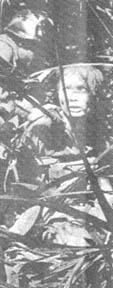 The enemy soldier may be a regular NVA, a regular Viet Cong soldier or a
part-time guerrilla. He is used to
hard work and can live without difficulty on as little as two pounds of rice a
day. He has received intensive political indoctrination and until
he sees otherwise, he is fighting to liberate the South Vietnamese people from
'U.S. aggression'.
The enemy soldier may be a regular NVA, a regular Viet Cong soldier or a
part-time guerrilla. He is used to
hard work and can live without difficulty on as little as two pounds of rice a
day. He has received intensive political indoctrination and until
he sees otherwise, he is fighting to liberate the South Vietnamese people from
'U.S. aggression'.
HOW
IS HE TRAINED?
The best trained are NVA
regulars. They receive about 30 days of basic training, although this period may
have been shortened, due to recent manpower shortages caused by heavy casualties
in the South.
The NVA recruit's training usually includes about 15 hours
of instruction on a basic North Vietnamese weapon. Viet Cong recruits undergo similar training when possible.
However, many VC receive only theory in classes and get practice in
actual battles.
Most of the older officers
commanding NVA and some VC units are veterans of the French-Indochina war.
The younger officers have been chosen from civilian ranks on the basis of
family standing or educational achievement.
All officers attend a military academy where they are taught tactics,
principles of guerrilla warfare, and fundamentals of weapons and leadership.
HOW
IS HE ORGANIZED?
In accordance with Communist
doctrine, the military is controlled by the political structure.
At the highest level, the NVA military is answerable to the Vietnamese
Communist Party. Viet Cong
activities are controlled by the National Liberation Front, which is a mere
screen for the Vietnamese Communist Party.
Enemy military forces in
South Vietnam are of three types: main force, local force and irregulars.
There are two types of main force units: NVA units, recruited in North
Vietnam, and Viet Cong units, recruited from the local South Vietnamese
population.
These main force units are
organized into divisions and regiments, and operate throughout large areas of
South Vietnam. The largest
independent local force unit is the battalion.
These local forces usually operate within their own province or district.
Smaller independent units, from independent companies to independent
platoons and squads, operate in even smaller areas.
The remainder of the
enemy's personnel are known as 'irregulars'. These are the full or
part-time guerrillas who may or may not be uniformed, and whose operations are
confined to extremely limited areas.
HOW
IS HE EQUIPPED AND SUPPLIED?
Once he is in South Vietnam,
the enemy must rely on a complex logistical system which has many primitive
elements - dirt roads, trails, cache sites and depots.
Arms, ammunition and
equipment are transported by rail, water and road from North Vietnam to the Ho
Chi Minh Trail and from there into South Vietnam.
Food is obtained from local South Vietnamese or from Cambodia.
Whenever possible, VC forces
live off the land. In some areas
they have been known to grow their own food. Hidden 'factories' produce some
crude weapons, explosives and other items.
WHY
DOES HE FIGHT?
The enemy has a number of
reasons for fighting. Some honestly
believe the Communist propaganda which they hear every day from their unit
political officer. The NVA regular
frequently serves primarily because it is considered a social disgrace to refuse
to bear arms. The Viet Cong is more
affected by these threats, and serves out of fear.
Viet Cong officers and NCO's have been known to summarily execute those
who did not 'stay on line'.
STRENGTHS
AND WEAKNESSES
The enemy's strength stems
largely from effective unconventional tactics, discipline and intimate knowledge
of the terrain. Masters at living
off the land, the enemy is able to hide among the people, in the jungle or in
the rural landscape.
His ability to withstand
hardships and his patient attitude toward life are also assets. A major weakness is that he is losing increasing numbers of
skilled and dedicated soldiers, and replacements are hard to find.
Another weakness is that many of the rank and file soldiers are
essentially captives recruited and involuntarily held in the armed forces.
Prodigal
M-79 Home At Last
By 1LT Mack D. Gooding
TAY
NINH
- You've heard of lost sheep returning to the fold, but how about an M-79
grenade launcher returning to its company after being lost and in enemy hands
for nine months?
When the 4th Battalion, 9th
Infantry, Manchus recently smashed a North Vietnamese attack on their Mole City
patrol base, 16 miles southeast of Tay Ninh, one of the enemy weapons Charlie
Company recovered was an M-79.
Checking the weapon's
serial number through battalion records revealed it was the same M-79 Charlie
Company had lost in a March ambush near Hoc Mon, 30 miles southeast of Mole
City.
The M-79 was welcomed back
by the Manchus with open cleaning kits, and is now back in action, pointing the
right way.
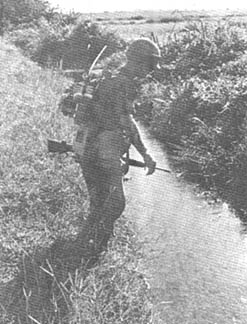 |
RARE SIGHT - This Tropic Lightning soldier pauses for a moment to contemplate a relatively unusual vision. Rarely during the dry season in Vietnam does a trooper in the 25th's area of operations come across a flowing stream, but this is proof that even nature doesn't get the word, sometimes. |
VC
Victim Returns - Walking
CU
CHI -
It was a combination of surprise and pleasure for Tropic Lightning 2d Brigade
staffers when Tran Van Bao returned from Saigon's National Rehabilitation
Center able to walk on his new artificial leg.
Despite weeks of planning
and careful coordination with families, agencies, and military channels, the
first complete success was, nonetheless, a welcome surprise.
And with that success, the
project got an approving nod for more such operations that will see dozens of
handicapped Vietnamese in Hau Nghia Province receiving new limbs.
Soon the second group of
four will be taken to the Rehabilitation Center for prosthetic consultation.
The first group reported to the center March.
These first eight, in addition to Tran Van Bao, come from three districts
in Hau Nghia and have disabilities including amputated arms and legs caused by
VC mines and artillery fire.
The importance of this
project is two-fold: First, it
accomplishes a portion of the MACV mission by aiding the people of Vietnam; and
second, it demonstrates concern of the allies for individuals.
Without the cooperation of
the Saigon Center, a Vietnam project of the World Rehabilitation Fund, Inc., the
project would have been difficult, if not impossible.
T h e Project headquarters
headed by Robert B. Wildon, carries on in the humanitarian tradition established
several years ago by founding chairmen Bernard Baruch, Herbert Hoover, and Harry
Truman. With funds from
international support groups and donations, the Saigon center treats hundreds of
patients free of charge each month.
While at the center, Tran
Van Bao, a 12-year-old villager, was given an artificial hand and leg and three
weeks of therapy and training in their use.
When the boy returned home he became a new person, a participant instead
of a spectator and a contributing member of his family.
The eight Vietnamese now
going through the Center range from a 45-year-old mother who lost an arm in 1967
artillery fire to another eight-year-old boy who lost his left leg in a Viet
Cong mine blast.
The 2d Brigade Civic Action
Office supports the drive to aid the unfortunate victims of war, along with many
other endeavors, under the guidance of Major Billy W. May, Bayou La Batre, Ala.
"We've had outstanding
cooperation from the people at the Rehabilitation Center," said Major May.
"They were very willing and eager to help.
With eight people to get appointments for, I thought it might take two or
three months but in fact it took only five days."
"This will probably do
more to win the support of the people for the government of Vietnam than any
other project we've taken part in," continued Major May.
"It's one of the best humanitarian projects we've had."
And for at least a score of Vietnamese civilians, there's now a
hope that was perhaps never there before.
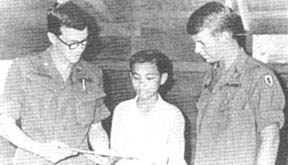 |
CLEAN BILL OF HEALTH - Back in Dau Tieng after an 18,000 mile round trip to Houston, Tex., for heart surgery, Nguyen Tan Hoang, 16, (center) looks at health records which declare he will be able to lead a normal life. Holding his medical records is Major Robert B. Perez of Niagara Falls, N.Y., commander of Bravo Company, 25th Medical Battalion. At right is First Lieutenant Larry C. Pitts of Greenville, S.C., who greeted the lad when his plane arrived in Saigon. |
Page 4-5 TROPIC LIGHTNING NEWS March 10, 1969
Wolfhounds
Uncover VC-NVA Base Camp Near Dau Tieng
DAU
TIENG
- Tropic Lightning infantrymen discovered a base camp stretching almost half a
mile which could house as much as an enemy regimental-size force near Dau Tieng.
The base camp included classrooms, an aid station, mess halls and an area
reserved for rest and recuperation.
The camp was discovered by
Wolfhounds of Bravo Company, 1st Battalion, 27th Infantry, in dense vegetation
three miles northwest of the 3d Brigade base camp at Dau Tieng.
A day earlier, the company,
commanded by Captain Frederick Wong of Honolulu, Hawaii, had found numerous
bunkers and fighting positions in two battalion-sized camps nearby.
The Wolfhounds were following up B-52 air strikes in an effort to catch
the enemy while he was stunned and unable to rest.
The infantrymen walked into
the enemy headquarters shortly before lunchtime and found steaming rice and pots
and pans full of warm food. It was
obvious that the enemy had beat a hasty retreat only minutes earlier.
Blood-stained bandages in the medical aid station inside the camp showed
that enemy medics had been patching up their wounded during the morning.
The Wolfhounds searched the
entire complex but failed to find anyone. Then
engineers of Delta Company, 65th Engineer Battalion went to work destroying a
dozen giant bunkers, each 25 feet long, as well as 29 fighting positions and a
network of tunnels. Among items
unearthed in the camp were rifles with loaded magazines, three RPG rounds and
several hundred rounds of small arms ammunition.
The mess hall, which had
three stoves and a smoke-dissipating system, included pots, pans, bottles and
various utensils. The classroom was
filled with picnic tables.
"This is quite a setup,"
said Wong. "Counting what we
found yesterday, I would estimate that this complex could be used to support an
enemy regiment or larger. "A lot
of enemy soldiers are going to be upset when they find out that the Wolfhounds
have eliminated this setup."
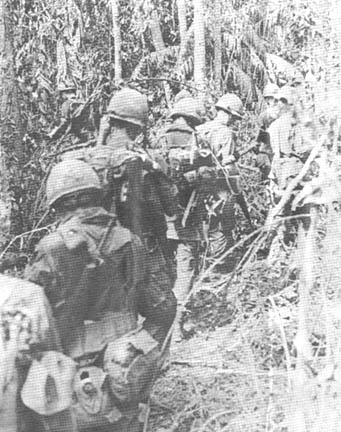 |
WOLFHOUNDS of Bravo Company, 1st Battalion, 27th Infantry proceed with caution through dense jungles near Dau Tieng. They were air-lifted into the area following a B-52 strike in the hope of catching the enemy stunned and off guard. The 3d Brigade soldiers discovered a huge enemy base camp complete with mess halls, briefing rooms and a command complex. |
| TOUGH NUT TO CRACK - Four layers of logs give this enemy bunker strong overhead protection. It was just one of many bunkers the Wolfhounds found three miles north of Dau Tieng. |
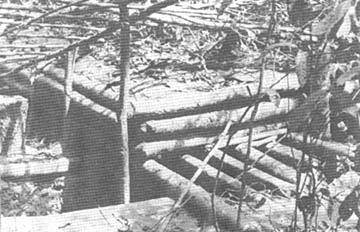 |
Page 6 TROPIC LIGHTNING NEWS March 10, 1969
Lucky
Lad Travels To States, Gets A New lease On life
By
SP5 Bill Sluis
DAU
TIENG
- Three months ago he was virtually a cripple, his skin showing a bluish cast
and his life functions weakening as the result of a severe heart disorder.
Today he plays stick-ball
with other teenagers from Dau Tieng village and faces the prospect of a healthy,
normal life.
"It doesn't hurt anymore
when I run," said Nguyen Tan Hoang.
The remarkable
transformation of the youth's heart is the result of an 18,000 mile round trip
to Houston, Tex., where he received a new mitral valve under the expert hands of
world famous heart surgeon Dr. Michael DeBakey.
The plastic valve makes a
slight clicking sound when heard through a stethoscope, but otherwise Hoang
(pronounced HWONG) is exactly like other 16-year-olds in Dau Tieng, 45 miles
northwest of Saigon.
The odyssey of the boy's
trip halfway around the world to find a new life was made possible by the
combined efforts of Tropic Lightning doctors and medics at Dau Tieng, and by Air
Force and civilian personnel, in Saigon and the United States.
According to Major Robert B.
Perez of Niagara Falls, N.Y., the delicate operation was "a 100 per cent
success." The youth's recovery from surgery was remarkably rapid.
The only after-effect of
Hoang's condition is the need for a mild drug which acts as a heart stimulant,
said Perez, commander of Bravo Company, 25th Medical Battalion.
Plans for the boy's trip
to Houston began after his condition was called to the attention of Captain
Bruce Greenfield of San Francisco during a medical civic action program.
Greenfield is now assigned to Oakland Army Terminal, Calif.
After Greenfield and Captain
Richard Brunswick of Philadelphia (now at Martin Army Hospital, Ft. Benning,
Ga.) wrote to Dr. DeBakey describing the youth's symptoms, the Houston surgeon
offered to perform the needed operation. It
remained only for the Air Force to provide the boy with a free lift, thanks to
the efforts of Lieutenant Colonel Richard N. Broughton of Tampa, Fla., in charge
of civic action at Tan Son Nhut airbase outside Saigon.
For Hoang, who never before
in his life had been more than 50-miles from home, the trip to the United States
aboard a C-141 'Starlifter' was filled with excitement.
He was the darling of nurses at the hospital, who admired his courage and
good spirits. They presented him with a radio, suitcase and wallet and brought
him ice cream during his weeks of recovery.
Before leaving Houston, he
got to see the Astrodome and stayed with two American families overnight.
On his return to Vietnam, he
stopped off in Colorado and saw his first snow.
"I made snowballs and threw them at one of the men from the plane,"
Hoang said with a smile.
When he arrived in Saigon,
he was greeted by First Lieutenant Larry C. Pitts of Greenville S.C., who
returned him to the base camp of the 3d Brigade.
Now living at home with his
parents, three brothers and a sister, Hoang still stops by almost daily to
enable Perez to check his pulse and administer his medicine. Friends among the medics, who raised more than $700 for the
youth's expenses, now invite him to participate in their daily volleyball
battles in the company area. Before
his operation the boy sometimes watched from the sidelines.
"Before the operation the
boy really had nothing to look forward to," said Perez.
"It was only a matter of time until his until his weak heart would have
affected his lungs, leading to his death."
Now the only shadow across
Hoang's life is the continuation of the war around his home town, which is the
first major settlement south of War Zone C.
"His operation was the result of the generosity of many people here in
Vietnam and in United States," said Perez. "I'm glad that my men and I
were able to play a role in bringing about such a wonderful medical victory."
| A DOG'S LIFE - Bingo, a tracker dog from the 66th Infantry Platoon (combat trackers) takes a short break after a mission to relax in the sun. The 2d Brigade pooch's handler is Sergeant Don Heath of Cody, Wyo. (PHOTO BY 1LT MICHAEL LINN) | 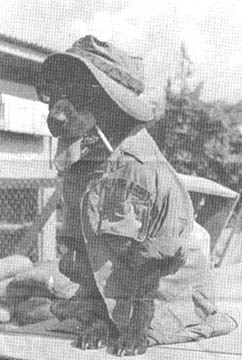 |
'Fastest
Pawn In East' Chalks Chess Victories
TAY
NINH
- You can't really blame them if his opponents are starting to call First
Lieutenant Albert E. Fontenot, Jr., of the 4th Battalion, 9th Infantry Manchus
"the fastest pawn in the East."
Fontenot, a medical
operations assistant, has been in Vietnam since November 27. During that time he's compiled a chess won-lost record of
117-1, which would be outstanding in anything except Russian roulette.
His only loss came against
Staff Sergeant Robert M. Lynch, the Manchus' administrative supervisor.
Fontenot, the battalion's medical operations assistant, explains the
loss this way:
"It was pretty late when
we started to play - which was usually the case - and by the time we got to his
particular game, it was 2 or 3 a.m. I
made one bad move, and Lynch took advantage of it.
That was all she wrote for the game.
Fontenot said he inherited
his interest in chess from his father.
"When I was little there
were always chess sets around our house, so I used to play with them as if they
were toy soldiers," he recalls. "I
learned how all the pieces moved by the time I was eight, but I didn't get at
all serious about the game until I was a senior in high school though."
While he contends that
he's still not really a good player, Fontenot is still a marked man among his
beknighted Manchu chess opponents.
Fontenot is a graduate of
Chicago's Roosevelt University. His
wife, Beverly, lives at 3748 W. Cermak Rd., Chicago.
Tomahawks
Pull Guard Protecting Rome Plows
TAY
NINH
- Smashing and leveling dense jungle, ripping and breaking tall, stout trees,
and clearing everything in their way are 23 giant Rome plows from the 65th
Engineers.
The Rome plow land-clearing
operation is taking place 14 miles southeast of Tay Ninh City. The objective: isolate the rubber trees to keep the enemy
from using the plantation as a hideaway.
While the engineers level
the earth, Company A, 4th Battalion (Mechanized), 23d Infantry, watches for the
enemy to harass the engineers.
In the past, enemy soldiers
have used the approaches to the big rubber for storing supplies and concealing
the movements of troops in and out of the plantation. The 12-day operation will eliminate this, making detection a
matter of visual reconnaissance.
"Land clearing operations
have proven their worth in Vietnam; they keep the enemy on the move," said
Captain Marion Cowan, of Clyde, Kans., operations officer.
"Our last land clearing operation, 18 miles southeast of Tay Ninh City,
lasted 15 days. We plowed through
the area, even though we were sniped at most of the time," commented Cowan.
"The Tomahawks are
standing guard this time, just in case. If
the enemy tries anything we'll be ready for them," said 1st Lieutenant
William Bradley, a native of Lexington, Ky.
"Charlie fears our Rome
plows as much as our weapons. Nothing
gets in our way; if we come to an obstacle that's too big or too tough,
we'll team up on it until we've conquered it," said Rome plow operator,
Specialist 4 Hiroshi Baba, of Waipahu, Hawaii.
The combination of Tomahawks
and Engineers working together has proved invaluable. It's a tough combo to beat.
Page 7 TROPIC LIGHTNING NEWS March 10, 1969
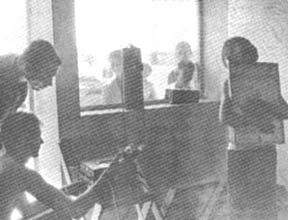 |
CURIOUS CHILDREN watch Specialist 4 William Reams of Monterey, Calif., a medic with 2d Battalion, 14th Infantry, use a portable X-ray machine at My Han compound near Duc Hoa. Captain Richard Tessler, of Miami, battalion surgeon, oversees the operation. (PHOTO BY SP4 E.R. JAMES) |
Dusters
Disrupt Plan Of Viet Cong Squad
DAU
TIENG
- By dim moonlight, a Viet Cong squad stepped from the edge of a woodline in the
Michelin Rubber Plantation. Across
a large clearing they could see the glimmer of perimeter lights surrounding Dau
Tieng base camp.
Suddenly a wall of fire came
toward them as tracers whizzed overhead. Shrapnel
impacted around them as projectiles exploded in the trees overhead.
Their plans disrupted, the enemy squad ran into the woods in disarray.
The dusters - M42 - Al tank
chassis mounting twin 40mm cannons - are used in many defensive roles.
They are operated by Bravo Battery, 5th Battalion, 2d Artillery, a II
Field Force unit in support of the 3d Brigade.
Designed primarily for
anti-aircraft defense, the dusters have been called upon in other defensive
roles including convoy protection.
"We've fired about 2,000
rounds in the past two months " said Specialist 4 Howard Doyle of Lasanimas,
Colo.
The light artillery was used to good advantage recently when an
estimated North Vietnamese battalion attempted to ambush a convoy rounding a
turn into the Ben Cui rubber plantation 45 miles northwest of Saigon.
Firing in close support of Bravo Company, 2d Battalion (Mechanized)
22d Infantry 'Triple Deuce,' the dusters blasted away many of the enemy
positions on both sides of the road.
When the dust of the battle
had cleared, 73 enemy were dead.
The duster's massive
firepower is made more deadly by its highly explosive projectile, which produces
flak when used against enemy aircraft.
Division
Doctor Begins X-ray Program To Rid Viets Of TB
CU
CHI -
A new field in MEDCAP (medical civic action program) capabilities has been
opened because of the efforts and resourcefulness of a 25th Infantry Division
doctor.
Captain Richard Tessler, of
Miami, surgeon for the 2d Battalion, 14th Infantry, became concerned with the
amount of tuberculosis among the Vietnamese people and decided to do something
about it. After some investigation,
he procured from the 25th Medical Battalion a portable X-ray machine that weighs
less than 40 pounds and is easily carried in two containers.
It can be operated in the field by the power generated by a jeep.
In a makeshift dark room of
three tarpaulins, Specialist 4 William Reams of Monterey, Calif. expertly
assists the doctor in changing the exposed film.
Reams, a medic with the Golden Dragons, has received special instruction
in developing X-ray plates and uses the facilities at the 25th Med.
"The results have been
startling," stated Tessler. "Of
those X-rayed, including children, 20 to 50 were infected by pulmonary TB."
"Once these people have
been identified an intensive drug therapy is begun that will last two years.
"This is a Vietnamese project and the people will receive their
medication from the government," stated the captain.
"We are merely initiating and overseeing the program."
Twiggyish
Pen Pal Signs Out '20-18-20'
By PFC Ralph Novak
TAY
NINH
- Sergeant First Class Walter S. Barefoot, has started writing to a young lady
in the U.S., but his wife won't mind: the girl is an eighth-grader who signs
her letters, "Your loving Twiggy, 20-18-20."
Barefoot, Four Oaks, NC.
who's NCOIC of personnel actions for the 4th Battalion, 9th Infantry is an
inveterate letter-writer, and has pen pals, mostly school children, all over the
U.S. But even he admits that
the letter he received recently from Enid Edwards of Galveston, Tex., was
extraordinary.
First she addressed the
letter to PFC Walter S. Barefoot, causing no end of laughter among Barefoot's
co-workers at Manchu headquarters. Then,
after putting Barefoot's complete military address both on the envelope and
inside the letter, she got into content:
"Dear PFC Walter S.
Barefoot R.A. 53154657,
"Hi! My name is Enid Edwards and I'm here to say Hi! How 'bout that? Well,
I am in the eighth grade at Weis Junior High and loving school!
I am kinda tall, very skinny with short blond hair and blue eyes.
I wear braces - yuk! Well,
some kids call me Twiggy, probably because it's a heck of a lot easier than
Enid."
"You soldiers must get
awfully lonely out there, but there are plenty of people back here lonely
without you. I often think about
you, and I'm grateful to you. Well
now, how did you like the election turnouts?
"Our school has the worst
football team in Texas. We've
lost all our games!
"I play flute in the band,
so I have to go to the games. I am
a majorette and my legs freeze at the games because of those ridiculous
short-shorts!
"Your loving Twiggy,
20-18-20 (signed) Enid Edwards."
Wolfhounds
In Firefight
CU
CHI -
A Second Brigade ambush patrol engaged six NVA soldiers, killing one, and
capturing his weapon and web gear.
"We spotted six NVA coming
across a marsh toward our position," said Specialist 4 John Quintrell, San
Diego, Calif., after the action. "We
first blew our claymores on them and opened up on them with everything we
had.''
The resulting firefight
lasted half an hour, during which gunships pounded the enemy who had advanced
within 15 meters of the Wolfhounds ambush site.
A search of the area after
the contact had broken revealed one NVA body, one AK-50 and one set of NVA web
gear.
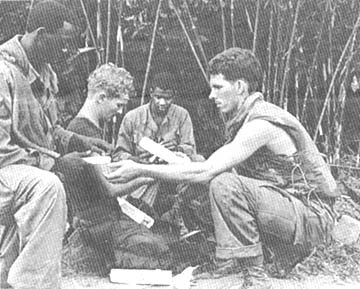 |
DEMO MEN PREPARE charges to blow a VC bunker. They are Privates First Class Michael T. Empel, Southgate, Mich., (2d from left) and Jim Hopkins, Cincinnati, (right) from C Company, 65th Engineers. The 'demo duo' is being helped by Privates First Class Joseph Leggett, Tampa, Fla., (left) and Reginald Williams, Richmond, Va. The latter two are from 2d Battalion, 27th Infantry Wolfhounds. (PHOTO BY SP4 KARL KARLGARRD) |
Like
Light
TAY
NINH
- Specialist 4 Lloyd H. Gray added new meaning to the 4th Battalion, 9th
Infantry Manchus' motto, "Keep Up the Fire," when he didn't have a
flashlight to explore a tunnel.
Gray discovered fresh
diggings that tipped off the Manchus to an abandoned enemy camp, and was given
the honor of exploring the first tunnel. With
no flashlight handy, Gray borrowed a trick from old ghost movies by wrapping a
piece of cloth around a stick, soaking it with insect repellent and setting it
afire.
The makeshift torch lasted
long enough for Gray to crawl about 100 feet through a winding tunnel 15 feet
underground. When the torch began
to sputter, he backed out, bringing with him a can of personal articles and an
enemy hand grenade, but no enemy tunnel rats.
"That was the first time
I'd ever gone into one of those tunnels, and when I came out, I was sweating
all over," Gray recalled. "It
wasn't hot down there, either."
| UP, UP AND AWAY - A Chinook from the 269th Aviation Battalion carries this 50-foot watch tower with ease from Ba Bep Bridge to Fire Support Base Crockett, to assist the 2d Battalion, 34th Armor. (PHOTO BY SP4 DOUG ELLIOTT) |
 |
Page 8 TROPIC LIGHTNING NEWS March 10, 1969
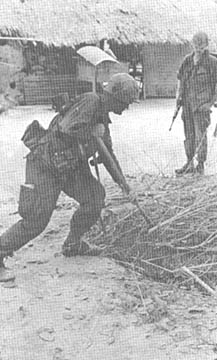 |
CHECKING IT OUT - Sergeant First Class John H. Warwick, Maxton, N.C., probes into soft soil while Specialist 4 John Schenk, a medic from Wallworth, N.Y., watches. Both men are from the 2d Battalion, 27th Infantry.
|
Manchus,
3/4 Cav Turn Back Attacking Enemy At Phuoc Luu
CU
CHI -
Moving from the safety of the Cambodian border, an estimated reinforced enemy
company occupied sections of Phuoc Luu, a village eight miles west of Trang
Bang. As soon as the local Popular
Forces noticed the arrival of the VC unit, they called for support from the 25th
Division.
Elements of the 3d Squadron,
4th Cavalry, moved quickly on the morning of January 25 to establish a defensive
position near the village. They
received sporadic fire from enemy positions.
By noon on the 25th the men
of the 3/4 Cav were joined by the 4th Battalion, 9th Infantry.
The Manchus had moved out of Fire Support Base Sedgwick on 15 minutes
notice. Since there had been
hostile fire from the hamlet, a psychological operations chopper broadcast the
message to the villagers that they should vacate the area.
It was later learned that each resident who left the dangerous area did
so under the threat of death from the VC terrorists.
Many refugees ignored the
Communist threats and arrived in Go Dau Ha on the afternoon of the 25th.
Most of the residents of Phuoc Luu managed to escape in time, but some
were not so lucky, as the enemy went on a murdering and burning rampage.
While Tropic Lightning
soldiers worked to establish a secure defensive position, D Troop of the Cav
moved cautiously into the hamlet. But as the horsemen approached, Charlie
decided the setting wasn't safe. The
Cav soldiers were greeted by the smoldering fires set by the retreating enemy.
D Troop remained inside the village at the PF compound ready for the
return of the terrorists.
Everyone seemed sure that
the scene of the action to come was not going to be Phuoc Luu, but the defensive
position nearby. Six Chinook
helicopter sorties brought in steel plating, sand bags, concertina wire and two
105mm howitzers as the Cav troopers and the Manchus continued digging and
building after the sun had left them. By
midnight the 25th Division soldiers were entrenched in fighting positions with
overhead cover, mechanized tracks and two artillery pieces.
The wait began.
They didn't have to wait
long. Fast work paid dividends.
At 1:00 a.m., January 26, the VC let loose.
Private First Class Michael
W. Tanner of La Habra, Calif., a radio-telephone operator for Charlie Company of
the Manchus remembered it this way: "I
finished digging my bunker about 12:30 a.m. and had maybe half an hour's sleep
before the stuff started coming in. They
were throwing everything you could think of at us."
Captain Ramon T. Pulliam of
Chatanooga, Tenn., commander of C Company, shifted his 90mm recoilless rifle
team to knock out the enemy forces zeroing in on the Cav tracks.
Nearly 100 recoilless rifle rounds were fired during the battle.
Gunships added firepower as
they hit the enemy repeatedly, and flares stole the night from Charlie. The
battle raged for two hours before the battered VC decided they had had enough.
A sweep of the area the next
day turned up 15 dead enemy three AK-47 assault rifles, 35 Chicom hand grenades,
26 mixed B-40 and B-41 rifle grenades and a light machinegun.
One suspect was detained. A
platoon from C Company Manchus swept through the village and joined D Troop of
the Cav, but there was no action to be found there.
Charlie had long since departed. The
men returned to their night laager to secure the area.
In Go Dau Ha, where the
villagers from Phuoc Luu had relocated, a medical civic action team supplied
food and shelter for the refugees. A
division civic action team was also sent to Phuoc Luu to assess the damage of
the village and undertake plans for future aid.
Siege
. . .
(Continued From Page 1)
east
end of the runway and were detained. During
the long night there were many instances of individual heroism.
"As the fighting became
savage we had to commit our reaction forces into the hottest areas," said
Captain Joseph Heeney of Fords, N.Y., assistant brigade operations officer.
"We formed small reaction forces from cooks, clerks mechanics
engineers, and military policemen. It's amazing how such an amalgam of units that are trained
primarily for other jobs were able to function so well."
Meanwhile helicopter
gunships and an AC-47 dragonship provided illumination and additional fire power
to infantrymen on the ground.
The fighting was the
heaviest in and around the base camp in the three years that American
infantrymen have used it as a jumping-off point for large-scale operations near
War Zone C.
Sergeant First Class Preston
Rowser, Detroit, Mich., moved to a position during the attack where he could see
the advancing enemy, knocking back any who dared advance.
Grenadier Specialist 4 Bruce
Brauman, Baltimore, Maryland, located a bunker held by the NVA soldiers and
poured fire on the enemy.
A final, powerful punch was
provided by Tropic Lightning artillery and gunships.
The big guns pounded the advancing enemy throughout the assault.
Fighting got so close at one
time that according to artilleryman Specialist 4 John Jasinkski, St. Paul,
Minn., "When I turned around and saw them on top of our protective berm, we
traversed the gun on them and started firing point blank. It was just like a firefight but we were using 105's."
Helicopter gunships poured
walls of lead on the enemy making low level passes in the midst of enemy fire.
Air strikes brought their powerful bombs up to the perimeter forcing the enemy
to retreat.
Combined body count for the
two nights of action approached upwards of two hundred NVA soldiers and
delivered serious damage to a prime enemy division.
Legs,
Pilots Trade Roles
CU
CHI -
There is an Army-Air Force exchange program in Vietnam that allows young
officers to become acquainted with the other branch.
Air Force First Lieutenant
Robert Deardorff, an A37 pilot with the 604th Special Operations Squadron, 3d
Tactical Fighter Wing at Bien Hoa, recently spent two days with Tropic Lightning
2d Brigade troops while an Army counterpart, First Lieutenant Dennis Gnas, of
the 2d Battalion, 12th Infantry, flew with the Air Force.
"This is a good chance for
us to see the Army at ground level," commented Deardorff, "and gain a little
more understanding of the feelings of the troops.
As pilots, our first concern is support of ground forces."
Deardorff spent two days
with the 2d Battalion, 12th Infantry at the Fire Brigade's Fire Support Base
Pershing, northwest of Cu Chi, seeing the troops in action and attending an
operations briefing.
Gnas of Hamtramck, Mich., on
the other hand, went aloft with the flyboys from the Bien Hoa-based wing in an
Air Force A37.
"I have to admit I was a
little apprehensive at first," said the Army officer, "But it was
exhilarating and interesting to see just what is involved in putting in an air
strike. I'm glad we've got them
up there," he concluded.
Officials who coordinate the
program hope to increase the appreciation and cooperation of our armed services
by such exchanges.
CRP
Shocks Enemy
DAU
TIENG
- Four members of an enemy mortar crew died as their own mortars were turned
against them after they fired on a Tropic Lightning patrol in the Michelin
Rubber Plantation.
Members of the Combined
Reconnaissance Patrol (CRP) of the 1st Battalion, 27th Infantry Wolfhounds were
fired on two miles east of Dau Tieng.
They were enroute to
reinforce a Provincial Reconnaissance Unit (PRU) of the Army of the Republic of
Vietnam. The PRU soldiers had just
finished a firefight in which they killed two enemy. As the first mortar struck First Lieutenant Patrick Smith of
Madera, Calif., CRP leader, could see that the fire was coming from behind an
old hootch near the plantation hospital.
"They were only 100 meters
away, so I asked for volunteers to smoke them out " said Smith.
While Smith called for
artillery and air strikes, three members of the patrol crept up behind the
hootch. They were Specialists 4
Carl Hathaway of New Canton, Ohio, Gary Simpson of Baltimore, and E.J. Mitchell
of Biloxi, Miss.
They were covered by other
CRP infantrymen including Sergeant John Mikita of Chicago, Specialist 4 Robert
J. Unser of Morrisonville, III., and Private First Class Wilken Walker of Des
Moines, Iowa.
The Wolfhounds came around
the hootch to confront the surprised enemy.
When the CRP soldiers opened fire, the enemy scattered. Three of those who were killed wore North Vietnamese Army
camouflaged fatigues while the fourth was clad in black pajamas.
Meanwhile the PRU soldiers
grabbed the enemy's 60mm mortar tube and seven rounds and began firing in the
direction the enemy crew had fled. The
captured mortar tube, three remaining rounds and several captured documents were
taken to the 3d Brigade base camp at Dau Tieng.
FSB
Diamond
(Continued From Page 1)
the cover of a barrage of mortar and rocket rounds. The enemy's attack was so devastating that for a short time
the southern portion of the perimeter was so covered with smoke, dirt and debris
that the area was neutralized.
Sergeant First Class Preston Rowser of Detroit, moved to a position
during the attack where he could see the advancing enemy, knocking back any who
dared advance.
A final, powerful punch was
provided by Tropic Lightning artillery and gunships.
Big guns pounded the advancing enemy throughout the assault.
Fighting got so close at one
time that according to artilleryman Specialist 4 John Jasinski, St. Paul, Minn.,
"when I turned around and saw them on top of our protective berm, we traversed
the gun on them and started firing point blank. It was just like a firefight but we were using 105s."
Combined body count for the
two nights of action by the Tropic Lightning soldiers was over 200.
Serious damage has been done to a prime enemy division.
Thanks to
Mack D. Gooding, 15th PID, 1st Bde., for sharing this issue,
Kirk Ramsey, 2nd Bn., 14th Inf. for creating this page.
This page last modified 8-12-2004
©2004 25th Infantry Division Association. All rights reserved.